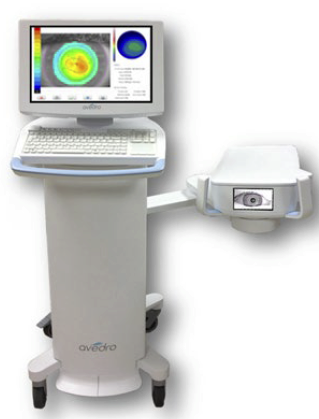Corneal collagen crosslinking (CXL) with ultraviolet-A (UV-A) light and riboflavin has not only revolutionized the way we manage patients with keratoconus and post-LASIK ectasia, but new innovations in customized crosslinking also have the potential to become the one of the biggest advances in the field of refractive surgery since the introduction of LASIK. While current refractive surgery techniques modify corneal curvature through the removal of tissue or the relaxation of the corneal stroma and therefore inherently weaken the eye, customized crosslinking induces changes in corneal curvature by adding strength. The application of customized U-VA illumination patterns for the treatment of refractive error through zone-specific crosslinking has been termed photorefractive intrastromal crosslinking, or PiXL.
Controlled corneal shape change can be obtained by regionally stiffening the stroma through PiXL, without weakening the cornea or removing tissue. A three-dimensional finite element analysis model developed by Dupps and colleagues has been used to generate patient-specific computational modeling of the response to CXL.1 This work has demonstrated the potential to induce specific biomechanical changes through the application of targeted delivery of crosslinking to regions of the cornea.2 The introduction of a new crosslinking system incorporating eye-tracking capabilities and programmable illumination patterns (KXL II; Avedro) has recently made clinical application of PiXL possible. Preliminary clinical evaluations are promising, with stable and repeatable flattening of corneal curvature obtained in normal corneas (without keratoconus or ectasia) through the application of high-irradiance, high-dose photorefractive intrastromal crosslinking in a 4-mm circular zone.3 However, the duration of the effect has yet to be determined.

Introduction of the KXL II
The prospect of a noninvasive refractive correction has the potential to dramatically change the landscape of refractive surgery. We currently must exercise caution in screening out refractive surgery candidates who are at risk for development of corneal ectasia. The introduction of customized crosslinking as a refractive procedure carries the potential to correct ametropia and simultaneously treat any underlying corneal instability. There are more than 90 million patients in the United States alone with myopic error of -2.40 D or less, and only 170,000 patients in this category receive LASIK surgery in the United States each year. With PiXL, we have the potential to offer 99% of these patients who did not receive surgical correction a nonsurgical approach to their vision correction needs. Patients who are currently unmotivated to seek surgical correction of their low refractive error due to fear of complications may be much more inclined to consider a procedure involving no tissue removal and carrying no inherent risk for iatrogenic ectasia. The potential to expand refractive surgery practice to include these patients could truly be a game changer.
1. Roy AS, Dupps WJ. Patient-specific computational modeling of keratoconus progression and differential responses to collagen cross-linking. Invest Ophthalmol Vis Sci. 2011;52(12):9174-9187.
2. Seven I, Roy AS, Dupps WJ. Patterned corneal collagen crosslinking for astigmatism: Computational modeling study. J Cataract Refract Surg. 2014:1-11.
3. Kanellopoulos AJ. Novel myopic refractive correction with transepithelial very high-fluence collagen cross-linking applied in a customized pattern: early clinical results of a feasibility study. Clin Ophthalmol. 2014;(8):1-6.






